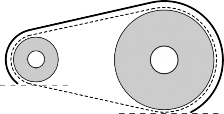
< Previous | Contents | Next >
T.5.2.1 Exposed high speed final drivetrain equipment such as Continuously Variable Transmissions (CVTs), sprockets, gears, pulleys, torque converters, clutches, belt drives, clutch drives and electric motors, must be fitted with scatter shields intended to contain drivetrain parts in case of failure.
T.5.2.2 The final drivetrain shield must:
a. Be made with solid material (not perforated)
b. Cover the chain or belt from the drive sprocket to the driven sprocket/chain wheel/belt or pulley.
c. Start and end no higher than parallel to the lowest point of the chain wheel/belt/pulley:

T.5.2.3 Body panels or other existing covers are acceptable when constructed per T.5.2.7 / T.5.2.8
T.5.2.4 Frame Members or existing components that exceed the scatter shield material requirements may be used as part of the shield.
T.5.2.5 Scatter shields may be composed of multiple pieces. Any gaps must be small (< 3 mm)
T.5.2.6 If equipped, the engine drive sprocket cover may be used as part of the scatter shield system.
T.5.2.7 Chain Drive - Scatter shields for chains must:
a. Be made of 2.66 mm (0.105 inch) minimum thickness steel (no alternatives are allowed)
b. Have a minimum width equal to three times the width of the chain
c. Be centered on the center line of the chain
d. Remain aligned with the chain under all conditions
T.5.2.8 Non-metallic Belt Drive - Scatter shields for belts must:
a. Be made from 3.0 mm minimum thickness aluminum alloy 6061-T6
b. Have a minimum width that is equal to 1.7 times the width of the belt.
c. Be centered on the center line of the belt
d. Remain aligned with the belt under all conditions.
T.5.2.9 Attachment Fasteners - All fasteners attaching scatter shields and guards must be 6mm or
1/4” minimum diameter Critical Fasteners, see T.8.2
T.5.2.10 Finger Guards
a. Must cover any drivetrain parts that spin while the vehicle is stationary with the engine running.
b. Must be made of material sufficient to resist finger forces.
c. Mesh or perforated material may be used but must prevent the passage of a 12 mm diameter object through the guard.